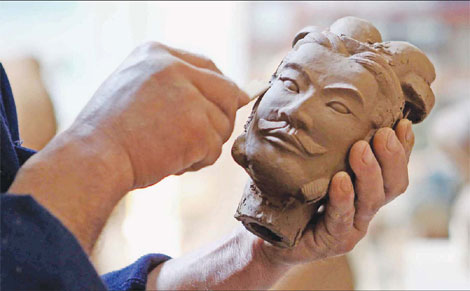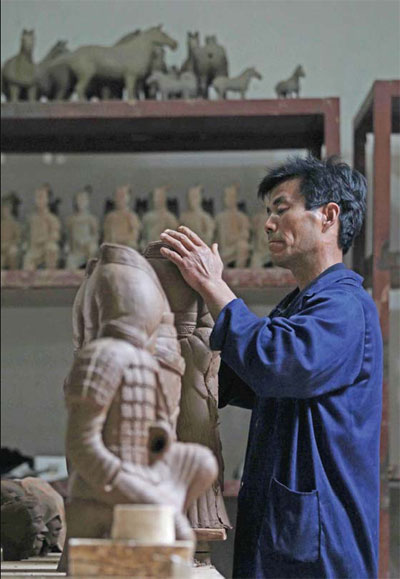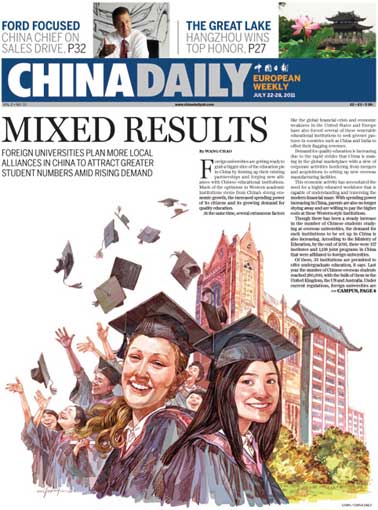Warrior redux
Updated: 2011-07-01 14:12
By Liu Lu (China Daily European Weekly)
|
|
Xi'an's Lintong district helps terracotta army finds its way into people's homes
In a spacious workshop, a middle-aged craftsman meticulously engraves patterns onto a large piece of brick-red clay with a bamboo strip. A handsome face of a man gradually emerges from the mold. His eyes are still, endowing him with a mysterious aura of timeless heroism.
Many other similar sculptures lie around the workshop. Some are life-sized works, while others are just a few inches tall.
But all are heavyset men, clad in armor with solemn faces.
Welcome to one of the souvenir factories specializing in imitations of terracotta warriors in Lintong of Xi'an, capital of Shaanxi province, where the world-famous relics rest.
There are nearly 30 of these factories in Lintong, the district's tourism society says. Last year, the workshops generated total revenue of 100 million yuan (11 million euros).
Thanks to rising demand for the replicas, the scale of the souvenir business has been expanding every year to become a major contributor to the local economy.
"The warrior-shaped figurine is the most desired souvenir for overseas tourists to Xi'an, because the terracotta warrior is a symbol of China's ancient, imperial past and one of the biggest tourist attractions in China," says Song Jiutuan, director of the Lintong district tourism bureau.
Lintong's booming tourism industry in recent decades has significantly stimulated the development of other travel-related businesses, enabling the terracotta replica manufacturers to benefit most from the trend, he says.
|
|
"In return, their development has injected new vitality to the local economy by creating employment and increasing local fiscal revenue, which ultimately contributes to Xi'an's overall economic development."
Just like the Great Wall in Beijing, the Terracotta Warriors of Shaanxi are a highlight for visitors to China. There is even an old saying: "A traveler who has not seen the Terracotta Warriors cannot claim to have visited China."
The terracotta army is a collection of life-sized clay sculptures arranged in formidable battle array and has been buried for two millennia to guard the sprawling tomb complex of Qin Shihuang, the first emperor of China.
Its excavation in 1974 is regarded as one of the world's most stunning archaeological finds of all time. Former French president Jacques Chirac called it the "eighth wonder in the world".
Every year, the site attracts tens of thousands of tourists from home and abroad to view the historical sight.
The overwhelming popularity of the terracotta warriors among world travelers has made their replicas an ideal gift to remember their trip.
For many history buffs, the lifelike reproductions are more than a decorative item - they are also a special collection offering an unearthly allure.
Narelle Rodway is an ardent fan of Chinese culture. She is particularly obsessed with the mystery surrounding the warriors.
But the 57-year-old Briton missed a chance to see the true colors of the clay army when part of the 8,000 unearthed figures toured London in 2007, as all the tickets were quickly sold out.
Rodway's disappointment was cleared after a recent trip to Xi'an. She finally saw the relics and brought home several warrior replicas.
The warrior replicas have become a way for many people like Rodway to show their affection for the authentic warrior statues.
"Those soldiers will help add an exotic oriental touch in my home and protect my family," Rodway says. She also intends to leave the clay figurines for her children. "Despite the fact that they are replicas, they are icons of an ancient civilization and a gateway for people to learn China."
A number of savvy businessmen have spotted the opportunity behind the warrior craze and started to tap this particular souvenir market as early as the 1990s.
Ling Guozheng, 57, is considered to be the first man in Lintong to start the replica business in 1993. His company, Xi'an Da Qin Terracotta Art Factory, is now the biggest warrior souvenir manufacturer in Xi'an.
"Our replicas are modeled according to the original warriors presented in the museum. Every effort has been made to ensure an exact match to the exquisite details of the original," he says, adding that the craftsmanship of the original terracotta figures reached a surprisingly high level in the Qin Dynasty (221-206 BC).
Ling explains there are seven major steps from clay to finished product that normally take three to four weeks.
"Craftsmen today only have to carve out different facial expressions of each figurine, as the use of molds has greatly simplified the production process."
Ling says the choice of clay, craftsmanship and the kilning time and temperature decide the quality of a replica. "A high quality figurine sounds crisp when tapped," he says.
The common clay figures of 10 to 15 centimeters usually sell at 70 to 80 yuan. But the life-sized sculptures are priced between 5,000 yuan and more than 10,000 yuan.
Ling's company sells about 300 warrior replicas every month. Sales revenue last year reached nearly 3 million yuan.
Despite the increasing cost of production, Ling says his business is getting better thanks to the soaring orders from overseas clients, with 70 percent of the customers coming from Europe.
"My products have been sold to more than 80 countries and regions by far, and more locations will be added onto this list," he says. "Following the footsteps of visitors, the Qin Terracotta Warriors and Horses will be found everywhere in the world."
E-paper

Ringing success
Domestic firms make hay as shopping spree by middle class consumers keeps cash registers ringing in Nanjing
Mixed Results
Crowning achievement
Living happily ever after
Specials

Ciao, Yao
Yao Ming announced his retirement from basketball, staging an emotional end to a glorious career.
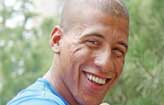
Going the distance
British fitness coach comes to terms with tragedy through life changes
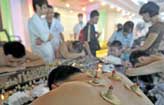
Turning up the heat
Traditional Chinese medicine using moxa, or mugwort herb, is once again becoming fashionable
